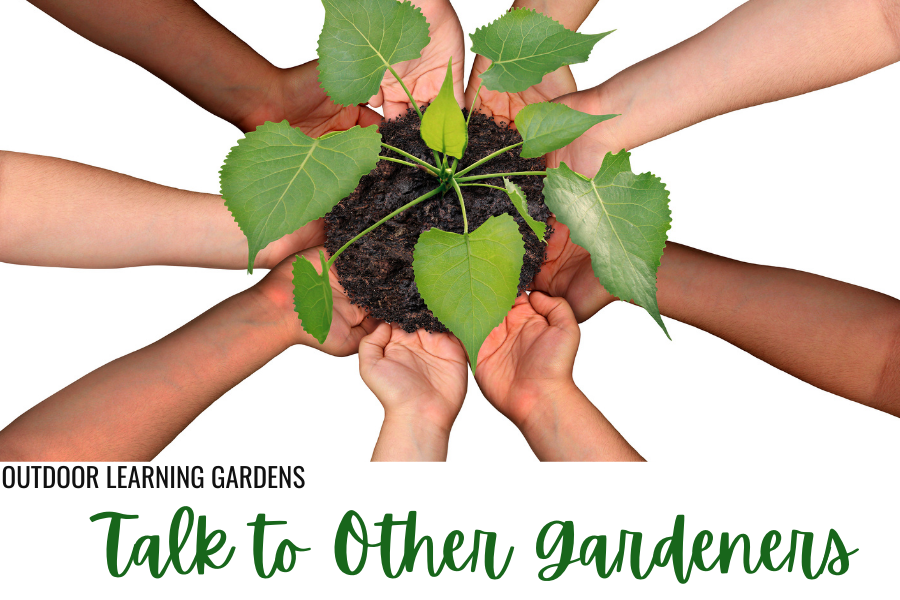An outdoor learning garden is an amazing teaching tool for many ages. Gardening with children is becoming more and more popular. If you’re not sure where to start or what to plant, keep reading because I have 9 great tips to help you get started!
What you plant in your outdoor learning garden depends on many factors. You’ll need to know and consider these factors before choosing the plants that you’re going to grow. Beginning with asking children if they have preferences on what to grow is a great start! Also, you could tie in what you grow through curriulum connections.
Gardens for outdoor learning provide a myriad activities to do with students. In December, my students plant a rhizome of ginger. During that month, we do many gingerbread house activities and end it with the planting of a ginger rhizome. The students learn about growing conditions, make observations and take pride in their accomplishments (go green thumbs!) By the end of the school year, most of the students’ ginger plants are ready to be planted outside. Some students eventually harvest their ginger, dry it out, and grate it for use as a spice.
Here are 9 great tips on how to decide what to grow in your outdoor learning garden:
1. Go by Your Climate Zone
Before you even plan an outdoor learning garden, you need to know your climate zone. In the USA, you can find your zone by using the USDA (United States Department of Agriculture) map. In Canada, you can use Natural Resources Canada to find your hardiness zones.
Links:
USDA map
Natural Resources Canada

2. Understand Your Area
Once you know what zone you’re in, you need to read up on the zone to know what plants work well in your area. The more you understand about your local area, the better you’ll do choosing the right plants. Plus, get to know your own land. Find out what plants are already growing naturally.
This is an opportunity to have students make connections to the land they live on, it’s weather and maps.
3. Talk to Other Gardeners
One way to really succeed with an outdoor learning garden is to talk to other gardeners in your area who are using these practices. You may even be able to find a professional to help you get started. The first couple of years of your outdoor learning garden is very important and can be helped by professionals.
There are many projects involved in helping educators get their gardens started. If you have experience with any of these, please share in the comments below.

4. Use Native Plants in your garden
The best way you can make your garden more climate-friendly is to use native plants. What plants have a history of growing in your area and are considered native to the area? How can those plants work for you and serve your garden? When you plant native plants, they are ready for the environment.
Students can do research projects on a specific plant native to their zone.
5. Avoid Lawns when building an Outdoor Learning Garden
Instead of planting grass lawns, consider using native ground covers that will look just as beautiful and require less care. Grass takes a lot of water to keep it healthy, as well as a lot of labor that can best be used elsewhere.
Clover is a great option as it doesn’t require mowing, attracts insects and is a lot of fun. Think: four-leaf clover hunts! Learning outdoors can be a lot of fun for students.
6. Buy Younger Healthier Plants
When you buy plants, go for the younger and healthiest plants that your local nurseries offer. Ask your local garden shop where they got the plants and what their gardening practices are to be on the safe side.
7. Learning through Container Gardening
One way to help your outdoor learning garden is to also use some containers made from bamboo and other sustainable or recycled containers. Then you can move these containers to safe places if the weather is bad.
This system is also ideal for school communities. Often, schools are closed during summer vacation and the potted plants can be re-homed temporarily.
8. Plant Fruit Trees
One way to affect the climate in your garden is to plant trees. Planting fruit trees does double duty to provide fruit and cover, which can shade super-hot areas of your outdoor learning space and protect less hardy plants.
Students have a first-hand opportunity to learn about plant life cycles, too. They can pick fruit, clean it and eat it. How rewarding!
9. Don’t Overwater your Garden
Another key for any plants that you take care of in your garden is to avoid overwatering. That means that you should use hardy, drought-resistant plants that are native to your area so that you can water less.
Growing an outdoor learning garden will not only help you teach children about global climate change, but it will also change the climate for the better. Grow plants native to your area, meant for your climate, and don’t use unnatural methods to encourage growth.
In this way, you’ll have plants in abundance that are healthier for students and everyone else too.
What kinds of things do you consider when planting in your outdoor learning garden? Let us know in the comments below.
Want to learn more about Gardening? Read more…
Climate-Friendly Gardens for Kids


2 Responses